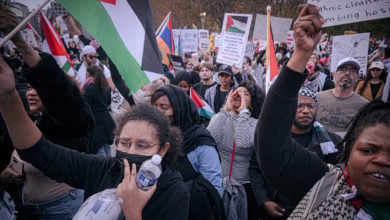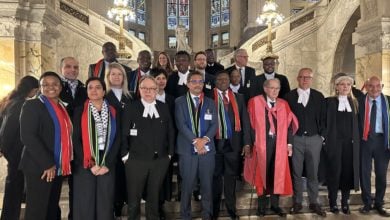We are sharing with our readers a three-part series published in soL, the weekly newspaper of the Communist Party, Turkey. The author, Selin Asker, is a soL news editor. At the beginning of March, as part of a Communist Party delegation, Selin traveled to Kobani to report on the destruction after the defeat of ISIL in Kobani as well as to conduct meetings with the Kurdish political leadership in Kobani. Liberation translation by Taylor Goel.
The people of Kobani are trying hard to pick up the pieces after the long battle with the Islamic State of Iraq and the Levant (ISIL). However given the level of destruction in the town, it looks like it will be a while before life is restored to normal.
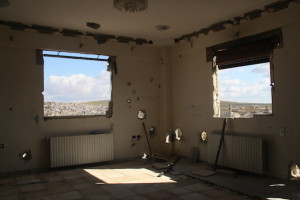
To report on the destruction after the defeat of ISIL, determine urgent needs and assess the recent developments in the region, accompanied by a delegation from the Communist Party, Turkey, the soL team started its trip to Kobani from the border town Suruç in the Urfa province of Turkey. As we approach the Mürşitpınar border crossing, the level of destruction in the town is clearly visible. When we reach the border, a giant YPG flag flying on the Turkey facing side of a half demolished building welcomes us. [YPG, People’s Protection Units, is the armed wing of the Kurdish Democratic Union Party (PYD) in Northern Syria].
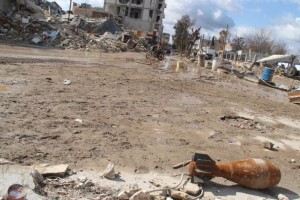
Security check, questions on the reasons for travel, phone-calls, waiting at the border crossing and then Kobani… Deputy Prime Minister Khalid Berkel and a delegation greet us. After a short greeting and chat, we start pounding the pavement. Our first impression is that it would not be an exaggeration to call Kobani a “ghost town”…
Kobani is an innocuous town. Even by observing the way the buildings are lined up in concord, one can notice proper city planning, before the war… At the moment, however, there is nothing left of the town but the rubble of bombed out buildings with furniture dangling from their windows, cars flipped over, unexploded mortar shells, pieces of human remains, streets reeking of death and people who are trying to get their houses and stores back in shape…
DESTRUCTION…
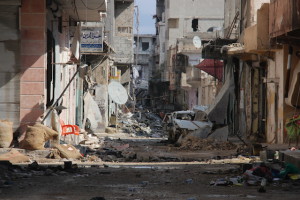
The town’s infrastructure is completely destroyed. There is nothing that would be necessary to sustain life. No power, no water, no sanitary sewer, no hospitals, no schools. Old men crouched in street corners with their heads in hands, kids and women wandering on muddy streets, guerrillas with weapons on their back, rarely seen peshmergas and mobile generators.
The generator is as vital as the issue of resistance itself. It is mentioned that giant generators and a transformer will be deployed for generating power soon.
At the moment, 3,000 people have returned back to the town which had a population of 200 thousand (villages included) before the ISIL attack. The children of the town are busy either running around unexploded mortar shells or carrying the incoming aid bags. Education for the kids is provided in a single building by a very limited number of teachers.
AŞİTİ SQUARE
In an area close to the Turkish border, our attention is caught by an enormous hole in the ground and a number of flipped-over cars. We learn that this was the result of a car bombing by ISIL by a car that traveled along the border before exploding.
A little further ahead is the Aşiti Square and a lot of unexploded mortar shells around it. The street corners are blocked by barricades made of barrels and cars riddled with bullet holes.
GOVERNMENT HALL
When we reach the Government Hall in Botan neighbourhood, bullet holes strike one’s eyes. Shell cases littered on every floor, bullet holes on the walls. At the peak of its attack, ISIL was able to get to the first floor of the building, the rest is history. In the meeting room, a TV destroyed by bullets. The top floor is overlooking the Miştenur Hill. It was mentioned that there was constant firing from Miştenur Hill, a strategic location as it is the only point with the bird’s eye-view of the whole town. The most fierce fighting took place around the Government Hall. After the fighting, everything has been left untouched. Blankets, countless shells, equipment, traces of the intense fighting are visible everywhere.
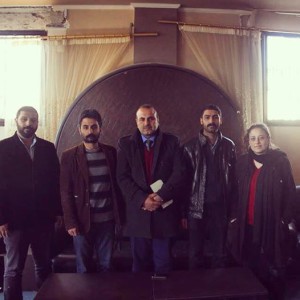
We meet with the Prime Minister of Kobani Canton, Enver Müslim, in the government hall. In addition to talking about the current developments, we also get the chance to ask a number of questions on various topics of him and his delegation which includes the Vice Prime Minister, deputies and a number of engineers.
We talk about many things: the opposition fighters to be trained in Turkey, PYD’s relations with the US and Barzani, their projections on the future of Kobani, their contacts with other Jihadist groups, their attitude towards the Damascus government and the recent Turkish “Suleyman Shah” operation… We get back a lot of striking information.
None of them left Kobani during the war, one can notice the war-fatigue on their faces. Both sides in agreement that this was a mutually candid conversation, we leave the building.
Next:
Coalition airstrikes took part in the destruction (Part 2)
Interview with Khaled Berkel, Deputy PM of Kobani Canton (Part 3)




